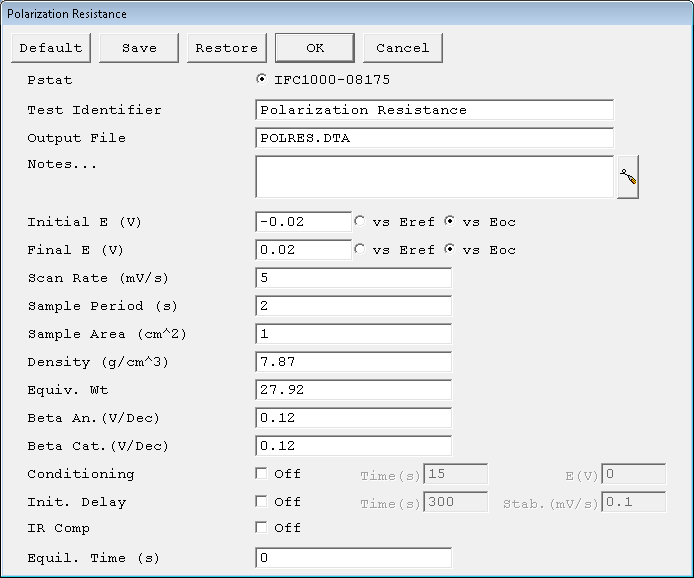Polarization Resistance Setup Parameters
Here is a Polarization Resistance Setup dialog box complete with its default parameters.

Initial E
Starting point for the potential sweep during data-acquisition. The allowed range is ±10 V with a resolution of 1/8 mV. Its accuracy depends on the setting.
Final E
Ending point for the potential sweep during data-acquisition. The allowed range is ±10 V with a resolution of 1/8 mV. Its accuracy depends on the setting.
Scan Rate
Speed of the potential sweep during data-acquisition.The Scan Rate is entered in units of mV/s. A practical bound on the Scan Rate is 100 mV/s. Higher Scan Rates may run, but yield unreliable data because the potentiostat’s compensation and filtering are set for long time constants. Custom scripts may allow Scan Rates of 1 V/s or more.A lower bound on the Scan Rate is the minimum Step Size divided by the longest Sample Period. For scans shorter than 2 V, the slowest Scan Rate is 52.1 nV/s or 0.1875 mV/hour. Multiply these limits by four for scans longer than 2 V.
Sample Period
Spacing between data points. It also helps determine the Step Size of the staircase ramp and the Number of Points in the data curve.The Sample Period sets the length of a step. The height of a step depends on both the Scan Rate and the Sample Period. Calculate the Step Size and the Number of Points in the scan from
Step Size = Scan Rate × Sample Period
Number of Points = Scan Range / Step Size
The Step Size is rounded to the resolution of the D/A converter making the steps. The resolution of the D/A converter is dependent on the type of potentiostat you use. Consult your potentiostat manual for more information. A typical Step Size for a polarization resistance scan is between 1 and 5 mV/step.If the step size has to be rounded to fit the resolution of the D/A converter, the sample period is also adjusted so that the scan rate is correct. The Number of Points must be less than that specified in GLOBALS.EXP. If you have more points, the experiment will abort just before the scan phase of the sequence. The units used for the Sample Period are seconds. The shortest Sample Period we recommend is 0.1 second. The longest Sample Period allowed is 600 seconds.

Comments are closed.